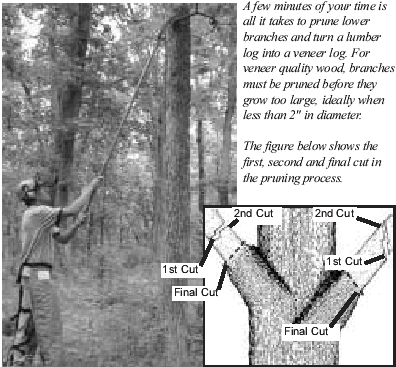R. Scott Brundage
Consulting Forester/Tree Farmer
Many landowners liken having veneer logs in their timber sale to winning the lottery. However, unlike the lottery, a landowner can “stack the deck.” We hope these questions and answers from Scott will be helpful as you consider this profitable timber product.
Q. I have heard a veneer log is worth from 10 to 20 times more than a top log from the same tree, or most other logs from other trees. True or False?
A. That’s true, if it’s a veneer log. A veneer log is a
large (usually 18" dbh or more), straight log which has
very few or no defects, including limbs, limb scars,
holes, ring-shake or separation, lightning scars, pin
knots, etc.
Other factors, such as sapwood
width, color, ingrown bark, and
mineral stains are also quality considerations.
In summary, a highvalue
veneer log is a nearly perfect
log.

Q. I want high dollar veneer logs from my timber. Can I produce such logs?
A. Yes, if you correctly manage your timber. First, you have to manage veneer species for veneer logs. Black walnut and white oak produce more than 89 percent of Missouri’s veneer logs. Add red oak and black cherry, and you have four species that produce more than 98 percent of our state’s veneer logs. Other species, including ash, maple, hickory, red cedar, etc., occasionally produce a veneer log, but these trees combined represent less than two percent of veneer logs.
Q. My woods contain some black walnut, white oak, and some red oak, along with other species. What do I do to produce, or “make,” a veneer log?
A. Select the largest, straightest and most full-crowned young trees that are ideally three to five inches in diameter. These potential veneer trees can produce veneer logs if properly released so that they can grow tall; all vines are removed; and they are properly pruned to ensure clear, defect-free logs. Note that I use the word properly — there is a right way and a wrong way. If you properly manage these potential veneer trees, you have an excellent chance to sell veneer logs.
Q. I want to manage my forest the right way. How, or where, can I learn more?
A. The best and most immediate step is to join the Walnut Council, which is by far the best organization I have found in 44 years as a professional forester and Tree Farmer. Upon joining, you will receive the best management bulletins available and a quarterly magazine loaded with "how-to" information. You will also have the opportunity to attend at least two state field day meetings and an annual national meeting. Interested parties may send a $30 check payable to the Walnut Council, c/o Dusty Walter, Secretary, Center for Agroforestry, 203 ABNR Building, University of Missouri, Columbia, Mo., 65211.
Q. Can you tell me more about the Tree Farm Program?
A. The Tree Farm Program is an excellent national program. It is also a recognition program for those that have completed some forest management following a management plan. The Walnut Council is more of a “how to” management organization, great for new or even more experienced forest managers. In fact, the best advice is to join the Walnut Council and learn to manage your timber, then become a Tree Farmer under the Tree Farm Program.
Remember, if you want to make much more money from your timberland and add value to your property, join the Walnut Council to learn how. If you own it — manage it!